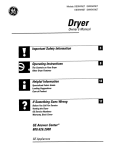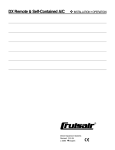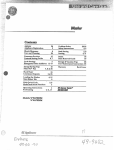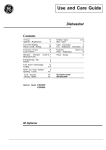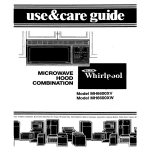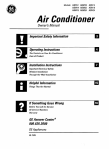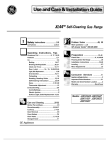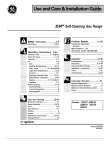Download GE DBLR453GT User's Manual
Transcript
Models: DBLR453ET DBLR453GT Dryer Ownerk Manual Important Safe* Information Operating Instructions The Controls on Your Dryer Other Dryer Features GE Answer Center@ 800.626.2000 GE Appliances Welcome to the GE family. We’re proud of our quality products and we believe in dependable service. You’ll see it in this easy-to-use manual and you’ll hear it in the friendly voices of our customer Best of all, you’ll experience these values each time you do the laundry. That’s important, because your new dryer will be part of your family for a long time. service department. Staple your receipt to the inside back cover of this manual. Write down the model and serial numbers here. They are on the label on the front of the dryer behind the door. Before Model number Serial number Date of purchase Before you call for service, Help us help you 800.626.2000 2 there are a few things you can do to help us serve you better. Read this manua/. It contains instructions to help you use and maintain your dryer properly. Save time and money Check the section titled “If Something Goes Wrong” before calling. This section was designed to solve common problems you might encounter. If you do need service, you can relax knowing help is only a phone call away. A list of toll-free customer service numbers is included on the inside back cover. Or call the GE Answer Center” at 800.626.2000, 24 hours a day, 7 days a week. Para obtener la version en espaiiol de este manual, Ilame a GE Answer Center@, servicio de informaci6n para el consumidor, tel~fono 800.626.2000. 3 Read all safety information before using s Use this appliance only for its intended purpose as described in this Owner’s Manual. ● This dryer must be properly installed and located in accordance with the Installation Instructions before it is used. If you did not receive an — Gas dryers MUST be exhausted to the outside. Carefully follow the Exhausting details in the Installation Instructions. — Exhausting electric dryers to the outside is STRONGLY RECOMMENDED to prevent large amounts of moisture and Installation Instructions sheet lint from being blown into the room. Carefully follow the Exhausting details in the Installation Instructions. with your dryer, you can obtain one by calling, toll free, the GE Answer Center”, 800.626.2000. — Properly ground to conform ● with all governing codes and ordinances. Follow details in ‘ $peciflcally recommended in this (Owner’s Manual or in published 1user-repair instructions that you 1understand and have the skills to carry out. — Install or store where the tempera- ture is above 50°F. (lO°C.). Do not install the dryer where it will be exposed to the weather. circuit to avoid elec~ical overload. zny part of the appliance or ,lttempt any servicing unless Installation Instructions. – Connect to a properly rated, protected and sized power supply 1Do not repair or replace ● men disconnecting this appliance pull by the plug rather than the cord to avoid damage to the cord or junction of cord and plug. Make sure that the cord is located so that it will not be stepped on, tripped over or otherwise subjected to damage or stress. 4 uv ● . Exhaust Duct—See Installation or flexible metal 4“ diameter have been cleaned in, washed in, soaked in, or spotted with ductwork inside the dryer cabinet combustible or explosive or for exhausting to the outside. USE OF PLASTIC OR OTHER substances (such as wax, paint, oil, gasoline, degreasers, dry- COMBUSTIBLE DUC~ORK CAN ~USE A FIRE. PUNCTURED DUC~ORK cleaning solvents, kerosene, etc. ) which may ignite or explode. Do not add these substances to the CAN CAUSE A FIRE IF IT COLLAPSES OR BECOMES OTHERWSE RESTRICTED IN USE OR DURING INSTALLATION. wash water. Do not use these substances around your washer and/or dryer during operation. Instructions. Use only rigid metal . Do not dry articles containing used a cleaning solvent, or which contains flammable materials (such as cleaning tennis shoes, galoshes, bath mats, rugs, bibs, baby pants, plastic bags, pillows, etc.) as these materials may melt or cloths, mops, towels used in beauty salons, restaurants, or barber shops, etc. ) must not be placed in or near the burn. Also, some rubber materials, when heated, can dryer until all traces of these combustion. ● . Any article on which you have rubber, plastic, or similar materials (such as padded bras, under certain circumstances produce fire by spontaneous ● Do not wash or dry articles that Do not store items that may flammable liquids or solids and their fumes have been removed. There are many highly flammable items used in homes such as acetone, burn or melt (such as clothing, paper material, plastics or plastic containers, etc.) on top denatured alcohol, gasoline, kerosene, some household of the dryer during operation. turpentines, waxes, wax removers and products containing petroleum distillates. Garments labeled “D~ Away from Heat” or “Do not Tumble Dry” (such as life jackets contain- cleaners, some spot removers, ing Kapok) must not be put in your dryer. 5 Read all safety information before using . Clean the lint filter before each load to prevent lint ● near children. Do not allow WTHOUT THE LINT FILTER IN PMCE. discarded appliance. Dispose of discarded appliances and shipping or packing materials properly. Before discarding a children to play inside, on, or with this appliance or any Keep the area around and underneath your appliances free from the accumulation dryer, or removing from service, remove the door of the dryer compartment. ● The interior of the machine and the exhaust duct connection inside the dryer should be cleaned periodically Never reach into the dryer while the drum is moving. Before loading, unloading or adding clothes, wait until the drum has completely stopped. ● ● ● To minimize the possibility of electric shock, unplug this appliance from the power supply or disconnect the dryer at the household diswibution panel by removing the fuse or switching off the circuit breaker before attempting any maintenance or cleaning (except the removal and cleaning of the lint filter). ● NOTE: Turning the Cycle Selector knob to an OFF position does NOT disconnect the appliance from the power supply. Do not dry fiberglass articles in your dryer. Skin irritation up by clothing during subsequent dryer uses. 6 The laundry process can reduce the flame retardancy of fabrics. To avoid such a result, the garment manufacturer’s care instructions should be followed very carefully. Keep the floor around your appliances clean and dry to reduce the possibility of slipping. could result from the remaining glass particles that may be picked ● Keep all laundry aids (such as detergents, bleaches, fabric softeners, etc. ) out of the reach of children, preferably in a locked cabinet. Observe all warnings on container labels to avoid personal inju~. by a qualified individual. ● Close supervision is necessary if this appliance is used by or accumulation inside the dryer or in the room. DO NOT OPEWTE THE DR~R of combustible materials, such as lint, paper, rags, chemicals, etc. ● ● Do not tamper with the controls. Do not operate this appliance if it is damaged, malfunctioning, partially disassembled, or has missing or broken parts, including a damaged cord or plug. Never climb on or stand on the dryer top. ● If yours is a gas dryer, it is equipped with an automatic electric ignition and does not have a pilot light. DO NOT ATTEMPT TO LIGHT WTH A MATCH. Burns may result from having your hand in the vicinity of the burner when the automatic ignition may turn on. ● You may wish to soften your laundered fabrics or reduce the static electricity in them by using dryer-applied fabric softeners or an anti-static conditioner. We recommend you use either a fabric softener in the wash cycle, according to the manufacturer’s instructions for those products, or try a dryer-added product for which the manufacturer gives written assurance on the package that their product can be safely used in your dryer. Service or performance problems caused by the use of these products are the responsibility of the manufacturers of those products and are not covered under the warranty of this appliance. SAVE THESE INSTRUCTIONS 7 - 7 1 he controls on your dyer A Clean the Lint Filter A Fabric Care Selections Clean the lint filter each time you use the drye~ Always follow Fabric Manufacturer’s Care Label CAUTION: Do not operate the dryer without the lint filter in place. or instructions when laundering. Use this chart as a general guide. Drying Selections Usage For regular to heav cottons. For syntheti~, blends and items labeled “permanent press.” For delimtes, syrrfhetics and items labeled ‘tumble dry low.” For ‘Yluffing” items without heat. Use the Timed Dy cycle. 8 Cycle Descriptions LESS DRY USSDRYPRESS * COOL OOWN ● MORE DflY 80MIN ● m ~ w TIMED DEWRINKLE DAMP A DRY DRY ~w A‘ Selecting Drying Cycle Select an automatic or timed cycle. See the above Cycle Descriptions. Starting Dryer . Close the dryer door. ● Select START. Opening the door during the operation till stop the dryer. To restart the dryer, close the door and select START to complete the cycle. See next page for othm dqmfeatures 9 Other dqe~features your model has Standard #2 Phillips screwdriver ● Tape-tippedpu~ knife ● Needle-nosed pliers ● 1 Open the door and remove the filler plugs opposite the hinges. 2 With the door completely open, remove the bottom screw from each hinge on the d~er face. 6 Rotate the door 180°. Insert it on the opposite side of the opening by moving the door IN and DOWN until the top hinge and the bottom hinge are resting on the top screws inserted in step 3. 3 Insert these screws about ha~way into the TOP holes, for each hinge, on the opposite side. (Where you removed the filler plugs.) Apply firm pressure to get the screw started in untapped holes. 7 Remove the remaining screws from the side of tie opening from which the door was removed. With these screws secure each hinge at the bottom. 4 Loosen the top screw from each hinge on the dryer face halfway. 5 With one hand holding the top of the door and the other hand holding the bottom, remove the 10 door from the dryer by lifting it UP and OUT. 8 Tighten the two top screws of each hinge. 9 Reinsert the plastic plugs on the side from which the door was removed. Always follow Fabric Manufacturer Care Label or instructions when laundering. Otherwise use the information below as a general guide. mom Mend any holes or weak seams where feather or filling could escape. Dry only one pillow at a time. Stop dryer occasionally and shake pillow, redistributing filling for even drying. Check pillow at the end of drying time. If it is not completely dry, reset dryer for more drying time. Dry on low heat only. CAUT/Ofl- Do not dry pillows containing foam rubber. Bltiem Add 2–4 dry towels and one blanket and set timer for 20–25 minutes. Dry only one blanket at a time. Do not set control for more than 25 minutes. At the end of drying cycle block the blanket back to i~ original shape. Allow blanket to dry thoroughly before storing. Comm Use a medium heat drying setting. .s~tietic Use a low heat drying setting. Do- Use a low heat drying setting. -a qe Ikm (Includes Use a low heat drying setting. comforters, b}ake~ md mattress pads.) Dry only one extra large item at a time. Set dryer for 20 minutes. men time is up, check and redistribute load. Reset dryer and check after 15 minutes. men time is up, check and redistribute load. Reset timer and check at 5 minute intervals. Check after each 5 minutes to ensure articles do not fill dryer drum. Large, wet articles should have ample room in the dryer, but as they dry and fluff up they may not have room to tumble. CAUTION: Items without room to tumble may block airflow and could result in scorched items. Dry matwess pads separately. Use a low heat drying setting. 11 Loading As a general rule, if clothes are sorted properly for the washer, they are sorted properly for the dryer. Sort by color (Separate colorfast from non-colorfast fabrics*) ● Lint producers: terry cloth and Whites ● Lights ● Darks chenille ● Lint collectors: velveteen and Separate by fabric type Sort by weight . Cottons and linens ● Permanent press cottons . Heavy Items ● and blends . Synthetic and poly knits ● Delicates ● Avoid drying veq small loads. corduroy ● Light Items * Non-cohrfatfah~ may bhed wfah, Soti @ individual COIW. . Do not dry the following items: . Sort clothes by weight so you won’t have to run an extra cycle for one or two heavier, slower drying items. . Fiberglass items ● Woolens . Rubber coated items ● Plastics . Do not add fabric softener sheets . Items with plastic trim . Foam-filled items once the load has become warm. This may cause fabric softener stains. . Do not overload. This causes inefficient operation and unnecessary wrinkling. Clothes need to tumble freely. 12 Separate lint producers from lint collectors The drum is rust-resistant and requires no special care. Wipe off any spills or washing compounds. Wipe or dust with a damp cloth. Try not to strike the surface with sharp objects. Dryer control panel and finishes may be damaged by some laundry pretreatment soil and stain remover products if such products are sprayed on or have direct contact with the dryer. b # /-’ B / - - Apply these pretreatment products away from the dryer. The fabric may then be washed and dried normally. Damage to your dryer caused by pretreatment products is not covered by your warranty. Before every dryer use, clean the lint filter. Moisten your fingers and reach into the filter opening. Run your fingers across the filter. To keep your dryer operating at peak performance, be sure to have a technician vacuum the lint from the machine every three years. To store your dryer for a short period of time, disconnect the power supply and clean the lint filter. 13 Care @ Cleaning Inspect and clean the dryer To clean the exhaust duct follow exhaust ducting at least once a year to prevent clogging. A these steps: partially clogged exhaust can lengthen the d~ing time. 1 Turn off electrical supply by disconnecting the plug from the wall socket. 2 Disconnect exhaust duct from the dryer. 3 Vacuum the exhaust duct with the hose attachment. 4 Reconnect the exhaust duct to the dryer. ● ● Make sure the inside flaps of the exhaust hood move freely (you may want to check with a mirror). Make sure inside flaps are fully open when dryer is operating. ● Check the inside of the exhaust hood with a mirror to rid of debris 14 Make sure there is not wild life (birds, insects, etc.) nesting inside the exhaust duct or hood. Problem ,“” ” Possible Causes What to Do Dryer is unplugged ● Fuse is blown/circuit breaker is tripped ● Fuse is blown/circuit breaker is tripped, the dryer may tumble but not heat ● Gas service is off ● Some shaking/noise is normal. Dryer may be sitting unewdy ● tiproper use of fabric softener ● Drying dirty items with c Use your dryer to dry only clean items. Dirty Check the house fuse/circuit breaker box and replace fuse or reset breaker. NOTE.Most electric dryers use two breakers. Check the house fuse/circuit breaker box and replace fuse or reset breaker. Make sure gas shutoff at dryer and main shutoff are fully open. Move dryer to an even floor space, or adjust as necessary until even. Follow directions on fabric softener package. items can stain clean items and the dryer. clean ones ~othes were not completely Make sure the dryer plug is pushed completely into the outlet. ● clean Sometimes stains which cannot be seen when the clothes are wet “appear” after drying. Use proper washing procedures before drying. Clean lint screen before each load. tit falter is fti ● hproper sorting ● Static electricity can attract tit ● See suggestions in this section under STATIC. krloading ● Separate large loads into smaller ones. Paper, tissue, etc. left in pockets . Empty all pockets before laundering clothes. Sort lint producers (like chenille) from lint collectors (like corduroy). 15 Problem Possible Causes What to Do “Try a fabric softener. ● Adjust controls for less drying. TV a fabric softener. No fabric softener was used ● Synthetics, permanent press “Try a fabric softener. and blends can cause stitic hproper sorting Large loads of heavy items (We beach toweb) ● ● Controk improperly set ● Lint fiiter is f~ ● hproper or obstructed ducting ● ● Separate heavy items from lightweight items (generally, a well-sorted washer load is a well-sorted dryer load). Large, heavy loads contain more moisture and take longer to dry. Separate large, heavy items into smaller loads to speed drying time. Match control settings to the load you are drying. Clean lint filter before every load. Check installation instructions for proper ducting/venting. Make sure ducting is clean, free of kinks and unobstructed. . Check to see if outside wall damper operates easily. . See the Venting the Dryer section. Blown fuses or tripped ● circuit bre&ers @erloading/ ● combining loads Underloading 16 ● Replace fuses or reset circuit breakers. Since most dryers use 2 fuses/breakers, make sure both are operating. Do not put more than one washer load in the dryer at a time. If you are drying only one or two items, add a few items to ensure proper tumbling. Problem Possible Causes What to Do . Select a shorter drying time. c Remove items while they still hold a slight amount of moisture. Letting items sit in dryer ● after cycle ends Some fabrics W naturfly shrink when washed. Others can be safely washed, but M shrink in the dryer. ● ● ● Remove items when cycle ends and fold or hang immediately. To avoid shrinkage, follow garment care labels exactly. Some items maybe pressed back into shape after drying. If you are concerned about shrinkage in a particular item, do not machine wash or tumble dry it. 17 Venting theDqer For the best drying performance the dryer needs to be properly vented. Carefully follow the details on Exhausting in the Installation Instructions. ● Use only rigid metal or flexible metal 4“ diameter duc~ork inside the dryer cabinet or for exhausting to the outside. ● 18 Do not use plastic or other combustible ductiork. ● Use the shortest length possible, ● Do not crush or collapse. . ● ● Avoid resting the duct on sharp obiects. Venting must conform to local building codes. Notes 19 Note%$ — 20 Notes 21 m ~ , We’ll be there! 800.626.2000 800-GE-CARES (800-432-2737) ~atever your question about any GE major appliance, GE Answer Center@ information service is available to help. Your call—and your question–will be answered promptly and courteously. And you can call any time. GE Answer Center” service is open AGE consumer setice professional Our factory-trained technicians know your appliance inside and out—so most repairs can be handied in just one visit. will provide expert repair service, scheduled at a time that’s convenient for you. Many GE Consumer 24 hours a day, 7 days a week. Service company-operated locations offer you service today or tomorrow, or at your convenience (7:00 a.m. to 7:00 p.m. weekdays, 9:00 a.m. to 2:00 p.m. Saturdays). 800.626.2000 Upon request, GE will provide Braille controls for a variety of GE appliances, and a brochure to assist in planning a barrier-free kitchen for persons with limited mobility. To obtain these items, free of charge, call 800.626.2000. Consumers with impaired hearing or speech who have access to a TDD or a conventional teletypewriter may call 800-TDD-GEAC (800-833-4322) to request information or service. Para obtener la versi6n en espafiol de este manual, name a 800.626.2000 800-626-2224 800-626-2002 GE Answer Center@, servicio de informaci6n para el consumidor, tel~fono 800.626.2000. You can have the secure feeling that GE Consumer Service will still be tiere after your warranty expires. Purchase a GE contract while your warranty is still in effect and you’ll receive a substantial discount. With a multiple-year contract, you’re assured of future service at today’s prices. Individuals qualified to service tieir own appliances can have parts or accessories sent directly to their home. The GE par~ system provides access to over 47,000 Instructions contained in this man- parfi...and all GE Genuine Renewal Parts are fully warranted. VISA, ual cover procedures to be performed by any user. Other servicing generally should be referred to qualfled service personnel. Caution must be exercised, since improper servicing may cause MasterCard and Discover cards unsafe operation. are accepted. We’re proud of our service and want you to be pleased. If for some reason you are not happy with the service you receive, here are three steps to follow for further help. Fimt contact the people who ser- Fina//v if your problem is still not resolved, write: Major Appliance Consumer Action Panel 20 North Wacker Drive Chicago, IL 60606 viced your appliance. Explain why you are not pleased. In most cases, this will solve the problem. Next, if you are still not pleased, write all the details—including your phone number–to: Manager, Consumer Relations GE Appliances, Appliance Park Louisville, KY 40225 23 Staple sales slip or cancelkd check hwe. Proof of otig’nalpurchase date is needed to obtain smice undo wawanty. ~LL ONE-=R WARRAN~ ***** ************************ ******* For one year from date of original purchase, we will provide, free of charge, parts and service labor in your home to repair or replace any pati of the d~athat fails because of a manufacturing defect. This warranty is extended to the original purchaser and any succeeding owner for products purchased for ordinary home use in the 48 mainland states, Hawaii and Washington, D.C. In Alaska the warranty is the same except that it is LIMITED because you must pay to ship the product to the service shop or for the service technician’s travel costs to your home. All warranty service will be provided by our Factory Service Centers or by our authorized Customer Care” servicers during normal working hours. Should your appliance need service, during warranty period or beyond, call 800-GE-CARES (800-432-2737). Service trips to your home to teach you how to use the product. Read your Owner’s Manual. If you then have any questions about operating the product, please contact your dealer or our Consumer Affairs office at the address below, or call, toll free: GE Answer Center” 800.626.2000 consumer information service . Improper installation. If you have an installation problem, contact your dealer or installer. You are responsible for providing adequate electrical, exhausting and other connecting facilities. ● Replacement of house fuses or resetting of circuit breakers. ● Failure of the product if it is misused, or used for other than the intended purpose or used commercially. ● Damage to product caused by accident, fire, floods or acts of God. ● WARRANTOR IS NOT RESPONSIBLE FOR CONSEQUENTML DAMAGES. =-g CG C4 Printed in Louisville, KY DBLR453ET DBLR453GT I

























